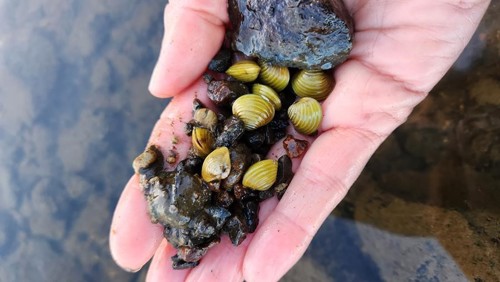

Surveillance undertaken in the Bay of Plenty for new-to-New Zealand gold clam
An immediate check of the Rotorua Te Arawa Lakes has been undertaken to determine if the invasive Asian freshwater gold clam, which was recently discovered in the Waikato, has also made its way into the Bay of Plenty.
Biosecurity New Zealand announced earlier this month that the new-to-New Zealand freshwater gold clam was present along a 50km stretch of the Waikato River. With up to 20% of visitors to the Rotorua lakes coming from the Waikato, Bay of Plenty Regional Council and Te Arawa Lakes Trust staff have already begun surveillance.
Hamish Lass Bay of Plenty Regional Council Biosecurity Team Leader (Marine & Freshwater), says, “We have completed snorkel surveillance at all the high-risk sites and found no evidence of the freshwater gold clam. This included around the boat ramps at the busiest lakes, which have lots of events and visitors coming from out of the region.
“Another key part of the response has been to undertake environmental DNA (eDNA) testing in key locations, which will flag the presence of the freshwater gold clam if it is in the water. We are awaiting the results of the first samples taken, and plan to continue with this form of sampling longer term.”
Biosecurity New Zealand advises that these clams, which only grow up to 2 or 3cm in length, can breed rapidly, with each adult being able to produce up to 70,000 juveniles a year. When present in large numbers, they can clog up water-based infrastructure, such as electric generation plants, irrigation systems and water treatment plants.
William Anaru Te Arawa Lakes Trust Operations Manager, comments that given the freshwater gold clams are filter feeders there is a real concern about their potential environmental impact.
“As the clam has never been found in Aotearoa before we just don’t know what impact they are likely to have on our native taonga species, such as kākahi.
“We know that this clam has become widely established in North and South America and Europe, and to date eradication hasn’t been possible. This means that preventing the freshwater gold clam from entering the Rotorua Te Arawa Lakes is a priority.”
Mr Lass says this is a timely reminder for all lake users to always ‘check, clean, dry’ when moving between waterways, and to follow the regional rules around certifying that their equipment is clean of invasive freshwater weeds or pests.
“By making sure people are self-certifying, as is required when using the Rotorua Te Arawa Lakes, we can help to prevent the clam making its way into the region, as well as any other unwanted freshwater pests.”
Everyone can help build a picture of where this clam is present by reporting suspected sightings to Biosecurity New Zealand.
If someone thinks they have seen the freshwater gold clam, they should note the location and take a photo if possible. They should then either phone Biosecurity New Zealand on 0800 80 99 66, or complete the online reporting form at report.mpi.govt.nz.
More information about the clam can be found at www.biosecurity.govt.nz/clam
CHECK, CLEAN, DRY advice for lake and river users
Follow these steps before moving to another location at the river, or to another river or lake.
Check
- Remove any visible matter, including any clams you can see, along with plant material or mud. Drain all river water.
Clean
- Do a washdown of your gear and watercraft with tap-water onto grass, beside the waterway or at home, and not into a stormwater drain system. This will flush off clam larvae, which can be too small to be seen.
- For gear made of absorbent materials, which will stay wet longer, apply a cleaning treatment.
Dry
- Allow gear to dry to touch, inside and out, then leave it to dry for at least five days.
Dry areas inside the watercraft where water has pooled, for example with an old towel, and then leave the craft to dry for at least five days. The hull of a watercraft will dry when towed.

